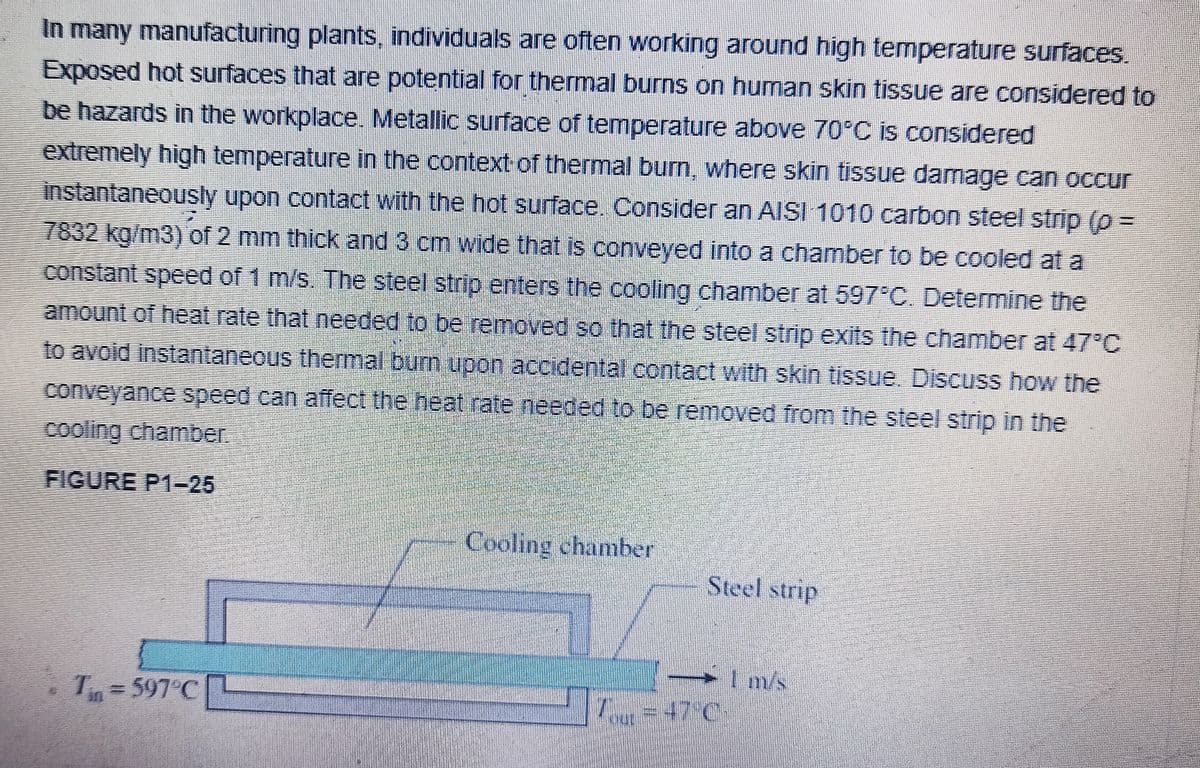In many manufacturing plants, individuals are often working around high temperature surfaces. Exposed hot surfaces that are potential for thermal burns on human skin tissue are considered to be hazards in the workplace. Metallic surface of temperature above 70°C is considered extremely high temperature in the context of thermal burn, where skin tissue damage can occur instantaneously upon contact with the hot surface. Consider an AISI 1010 carbon steel strip (p =D 7832 kg/m3) of 2 mm thick and 3 cm wide that is conveyed into a chamber to be cooled at a constant speed of 1 m/s. The steel strip enters the cooling chamber at 597°C. Determine the amount of heat rate that needed to be removed so that the steel strip exits the chamber at 47°C to avoid instantaneous thermal burn upon accidental contact with skin tissue. Discuss how the conveyance speed can affect the heat rate needed to be removed from the steel strip in the cooling chamber. FIGURE P1-25 Cooling chamber Steel strip 1 m/s Tn= 597°C out
In many manufacturing plants, individuals are often working around high temperature surfaces. Exposed hot surfaces that are potential for thermal burns on human skin tissue are considered to be hazards in the workplace. Metallic surface of temperature above 70°C is considered extremely high temperature in the context of thermal burn, where skin tissue damage can occur instantaneously upon contact with the hot surface. Consider an AISI 1010 carbon steel strip (p =D 7832 kg/m3) of 2 mm thick and 3 cm wide that is conveyed into a chamber to be cooled at a constant speed of 1 m/s. The steel strip enters the cooling chamber at 597°C. Determine the amount of heat rate that needed to be removed so that the steel strip exits the chamber at 47°C to avoid instantaneous thermal burn upon accidental contact with skin tissue. Discuss how the conveyance speed can affect the heat rate needed to be removed from the steel strip in the cooling chamber. FIGURE P1-25 Cooling chamber Steel strip 1 m/s Tn= 597°C out
Principles of Heat Transfer (Activate Learning with these NEW titles from Engineering!)
8th Edition
ISBN:9781305387102
Author:Kreith, Frank; Manglik, Raj M.
Publisher:Kreith, Frank; Manglik, Raj M.
Chapter8: Natural Convection
Section: Chapter Questions
Problem 8.8P
Related questions
Question

Transcribed Image Text:In many manufacturing plants, individuals are often working around high temperature surfaces.
Exposed hot surfaces that are potential for thermal burns on human skin tissue are considered to
be hazards in the workplace. Metallic surface of temperature above 70°C is considered
extremely high temperature in the context of thermal burn, where skin tissue damage can occur
instantaneously upon contact with the hot surface.. Consider an AISI 1010 carbon steel strip (p =
7832 kg/m3) of 2 mm thick and 3 cm wide that is conveyed into a chamber to be cooled at a
constant speed of 1 m/s. The steel strip enters the cooling chamber at 597 C. Determine the
amount of heat rate that needed to be removed so that the steel strip exits the chamber at 47°C
to avoid instantaneous themal burn upon accidental contact with skin tissue. Discuss how the
conveyance speed can affect the neat rate needed to be removed from the steel strip in the
cooling chamber.
FIGURE P1-25
Cooling chamber
Steel strip
Im/s
=47°C
Tn=597°C
Expert Solution
This question has been solved!
Explore an expertly crafted, step-by-step solution for a thorough understanding of key concepts.
This is a popular solution!
Trending now
This is a popular solution!
Step by step
Solved in 3 steps

Knowledge Booster
Learn more about
Need a deep-dive on the concept behind this application? Look no further. Learn more about this topic, mechanical-engineering and related others by exploring similar questions and additional content below.Recommended textbooks for you

Principles of Heat Transfer (Activate Learning wi…
Mechanical Engineering
ISBN:
9781305387102
Author:
Kreith, Frank; Manglik, Raj M.
Publisher:
Cengage Learning

Principles of Heat Transfer (Activate Learning wi…
Mechanical Engineering
ISBN:
9781305387102
Author:
Kreith, Frank; Manglik, Raj M.
Publisher:
Cengage Learning